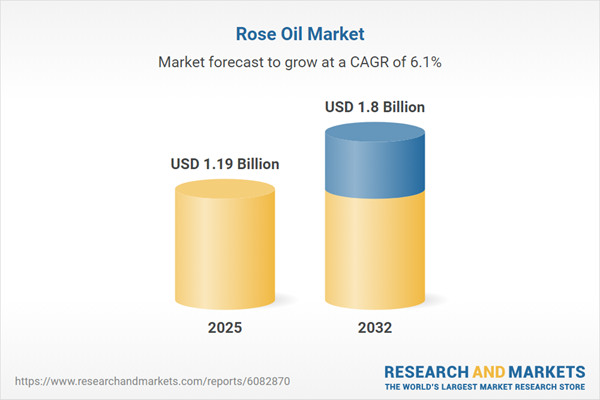Speak directly to the analyst to clarify any post sales queries you may have.
The rose oil market is evolving rapidly as demand for natural, sustainable ingredients reshapes sourcing, extraction, and branding strategies across industries. Senior decision-makers navigating this environment require robust insights into growth catalysts, regulatory developments, and competitive imperatives shaping global dynamics.
Market Snapshot: Rose Oil Market Growth and Outlook
The rose oil market grew from USD 1.12 billion in 2024 to USD 1.19 billion in 2025. With an expected CAGR of 6.09%, revenues are projected to reach USD 1.80 billion by 2032. Rising consumer preference for ethically sourced, multifunctional, and high-purity ingredients is propelling adoption across fragrance, personal care, wellness, and flavor sectors. In response, industry participants are prioritizing traceability, advanced extraction methods, and digital engagement to meet evolving end-user needs and maintain competitive positioning.
Scope & Segmentation: Strategic Framework for the Rose Oil Market
- Product Types: Conventional and organic rose oils address both cost-sensitive and clean-label, premium applications.
- Source Varietals: Rosa Centifolia, Rosa Damascena, and Rosa Gallica each serve distinct industry preferences, with premium use in perfumery and broad versatility in aromatherapy and wellness.
- Extraction Methods: CO₂ extraction, cold press, solvent extraction, and steam distillation are utilized, balancing purity, yield consistency, and sustainability.
- Applications: Cosmetics and personal care, food and beverage flavoring, household products, and therapeutics/pharmaceuticals, including hair care, perfumes, skincare, flavoring agents, teas, air fresheners, scented candles, aromatherapy, and medicinal uses.
- Distribution Channels: Offline retail (health and beauty stores, specialty stores, supermarkets/hypermarkets) and online retail channels support a mix of traditional and digital sales strategies.
- Geographic Coverage: Americas (North and Latin America), Europe, Middle East & Africa (including leading sites in Bulgaria, Morocco, and emerging Middle Eastern markets), and Asia-Pacific (notably China, India, Japan, and Southeast Asia) reflect diverse production and consumption patterns.
- Leading Companies: Industry coverage spans A.G. Industries Pvt, Ltd., Aaron Aromatics Limited, Alba Grups LTD, Alteya, Inc., Apex Flavors Inc., Augustus Oils Ltd., Berje Inc., De Monchy Aromatics Ltd., DSM-Firmenich AG, dōTERRA International, LLC, Ernesto Ventos S.A., Essential Oil Wizardry, Givaudan SA, INDIA AROMA OILS AND COMPANY, Merck KGaA, NHR Organic Oils Ltd., PerfumersWorld Ltd., Robertet Group, Rocky Mountain Oils, LLC, Symrise AG, Ultra International B.V., and Young Living Essential Oils.
Key Takeaways: Strategic Insights for Decision-Makers
- Technological advancements—especially in CO₂ extraction—are helping producers secure higher-purity oils, reduce environmental impact, and achieve greater process consistency.
- Evolving regulatory frameworks are increasing the importance of compliance and quality certifications, driving reformulations and investments in organic and cruelty-free processing.
- Brand differentiation relies increasingly on transparent supply chains and sustainability credentials. Blockchain adoption is supporting traceability goals and consumer trust.
- Diversification across application segments, including niche wellness and medicinal uses, supports broader revenue streams and enhanced resilience.
- Digital channels and e-commerce are extending market reach, capitalizing on consumer demand for direct information, ethical origin, and personalized shopping experiences.
Tariff Impact: Market Restructuring and Regional Adaptation
Revised import tariffs implemented in the United States in 2025 have triggered both immediate cost pressures and strategic realignments. Exporters in established supply countries are adapting pricing and exploring new markets, while US-based brands are investing in local sourcing and distillation. These measures are accelerating domestic industry growth, stimulating infrastructure enhancements, and supporting broader geographic diversification of supply chains.
Methodology & Data Sources
This analysis employs a rigorous research framework that combines in-depth primary interviews with industry executives and technical experts, alongside extensive secondary research. Triangulation of quantitative and qualitative data, including sector reports, academic publications, and trade database insights, ensures comprehensive and reliable findings.
Why This Report Matters: Actionable Intelligence for Leaders
- Clarifies market dynamics, enabling leadership teams to address evolving consumer preferences, supply chain vulnerabilities, and innovation opportunities.
- Delivers actionable recommendations for optimizing sourcing protocols, enhancing product differentiation, and meeting sustainability objectives.
- Supports strategic planning with up-to-date segmentation, regional analysis, and competitor benchmarks tailored for executive decision-making.
Conclusion
The rose oil market’s future will be shaped by advances in extraction technology, heightened sustainability standards, and agile adaptation to global trade dynamics. Stakeholders prepared to align their strategies with these forces are positioned for sustained growth and long-term resilience in an evolving landscape.
Table of Contents
3. Executive Summary
4. Market Overview
7. Cumulative Impact of Artificial Intelligence 2025
Companies Mentioned
The companies profiled in this Rose Oil market report include:- A.G. Industries Pvt, Ltd.
- Aaron Aromatics Limited
- Alba Grups LTD
- Alteya, Inc.
- Apex Flavors Inc.
- Augustus Oils Ltd.
- Berje Inc.
- De Monchy Aromatics Ltd.
- DSM-Firmenich AG
- dōTERRA International, LLC
- Ernesto Ventos S.A.
- Essential Oil Wizardry
- Givaudan SA
- INDIA AROMA OILS AND COMPANY
- Merck KGaA
- NHR Organic Oils Ltd.
- PerfumersWorld Ltd.
- Robertet Group
- Rocky Mountain Oils, LLC
- Symrise AG
- Ultra International B.V.
- Young Living Essential Oils
Table Information
| Report Attribute | Details |
|---|---|
| No. of Pages | 184 |
| Published | November 2025 |
| Forecast Period | 2025 - 2032 |
| Estimated Market Value ( USD | $ 1.19 Billion |
| Forecasted Market Value ( USD | $ 1.8 Billion |
| Compound Annual Growth Rate | 6.0% |
| Regions Covered | Global |
| No. of Companies Mentioned | 23 |








